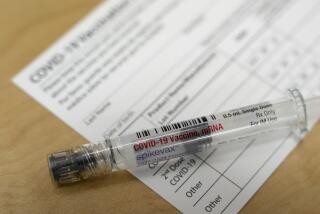This year’s flu shot could get complicated
- Share via
Government health officials said Tuesday that they were “looking intently” at developing a swine flu vaccine.
“It will be a matter of deciding not to make a vaccine rather than deciding to move forward,” said Dr. Richard Besser, acting director of the Centers for Disease Control and Prevention.
But undertaking work on a vaccine would be challenging. In a typical year, formulating the nation’s flu vaccine is a tricky proposition.
This is not a typical year.
As they contemplate the best way to protect the public from a possible pandemic, there are decisions to be made that could complicate the annual influenza vaccine campaign.
Should they reconfigure the seasonal flu vaccine that’s already under development for the fall? Or should they order up a second vaccine tailored to the new virus and trust people to take both shots?
Either option entails added expense, logistical headaches and no small measure of risk.
And since it takes about six months to produce the millions of flu shots that Americans will need in the fall, nobody can afford to wait.
The vaccine is made by growing samples of flu virus inside fertilized chicken eggs, then breaking out the key proteins that provoke an immune response. Then they are purified, tested and packaged into syringes for distribution around the country.
In February, a government advisory committee selected three flu viruses for this year’s vaccine, based on surveillance data indicating which strains are most likely to be circulating in the fall and winter and causing disease.
They chose an H1N1 strain called A/Brisbane/59/2007; an H3N2 strain called A/Brisbane/10/2007; and a strain known as B/Brisbane/60/2008.
Now that swine flu is on the scene, Besser said, it could be swapped for one of the other strains or added as a fourth.
Adding a fourth “is an attractive approach in that you would have one vaccine that would cover not just seasonal flu but this new strain that is circulating,” Besser said.
But such a decision won’t be easy, said Dr. Wayne Marasco, an infectious disease physician and virologist at Harvard Medical School.
Using a vaccine with four viruses instead of three “would probably change the cost of production, the time of production, and the packaging that goes with it,” he said.
Another idea is to replace one of the three viruses in the seasonal vaccine with swine flu virus. But “what would you be giving up?” Marasco said. They would have to consider, he said, how many extra people might get sick from regular, seasonal flu because of that decision.
Production of the seasonal vaccine is already moving forward, and Besser said the agency would like to avoid any delays. The vaccine usually becomes available to public health clinics in September and is first administered to people at highest risk for complications from flu, such as nursing home residents.
It would be difficult to reconfigure the seasonal flu vaccine because of the time manufacturers need to create it, said Dave Daigle, a CDC spokesman. Even getting the order for the vaccine in April or May “cuts it very close for them.”
Scientists are working on technology that would allow flu vaccines to be manufactured somewhat faster than the current method. Though the egg approach is reliable and has worked well for decades, it is ill suited to a potential pandemic and the increase in vaccine demand that comes with it.
“The disadvantage is you’re dependent on the roosters and hens to produce your substrate for flu vaccine every year,” said Dr. Edwin D. Kilbourne, a virologist and infectious disease specialist who is retired from New York Medical College.
The birds aren’t able to lay more eggs in accordance with the world’s need for flu vaccine, he said.
The CDC could instead order a separate swine flu vaccine. Scientists would try to combine a sample of the current swine flu strain with another virus that is proven to multiply quickly in eggs, Kilbourne said. The resulting strain would churn out thousands of copies of the virus that are genetically matched to the one sickening people now.
If two flu vaccines are produced, it’s likely that the CDC would recommend both to at least some groups of people, Daigle said.
But health officials would need to wait and see what transpires with the swine flu outbreak over the next few months.
“We would say, definitely protect yourself with a seasonal influenza shot,” Daigle said. “We’re not sure what will happen with this swine flu.”
--
karen.kaplan@latimes.com







